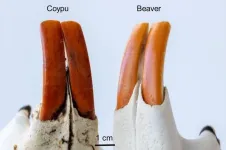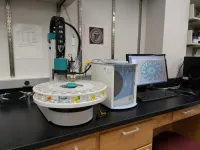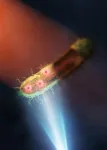(Press-News.org) Highlights:
In lab experiments, copper shows antimicrobial properties, including against pathogens like Salmonella.
Copper beads in animal feeds may improve gut health in pigs.
A new bead design effectively delivers copper to the lower intestine.
New findings show copper beads influence the microbial makeup in a pig’s gut, but more work is needed to optimize the benefits.
Washington, D.C. — April 17, 2024 — Copper is a natural antimicrobial material that, when added to pig feed, may promote the growth and health of the animals. Since pigs can tolerate high levels of the metal, researchers at Texas Tech University in Amarillo recently investigated whether copper might be used to promote their gut health and reduce the shedding of microbes to the environment.
This week in Microbiology Spectrum, the researchers report that small beads containing copper, when added to pig feed, effectively deliver the metal to the animal gut.
“The copper gets released in the animal system very slowly,” says microbiologist Alexandra Calle, Ph.D, the paper’s senior author. Instead of just being consumed and absorbed in the stomach, it remains for a longer period in the animal’s GI tract.
In the lab, Calle and her colleagues found that exposing Salmonella to the copper bead solution resulted in dramatic reductions in the population of the bacterial pathogen. Based on those results, they hoped that their animal experiments would show that the copper beads could reduce microbial pathogens in the gut, as well.
They divided a group of 48 6-month-old pigs—half female, half male—into 2 groups. During the second week of a 3-week study, the first group received normal feed, and the other received feed with added copper beads. Researchers collected feces from the pigs throughout the experiment, using atomic spectroscopy to measure copper levels and 16s RNA sequencing to identify microbial species.
Calle and her colleagues selected 2 families of bacteria to study as indicators of how the copper changed the gut microbiome. One was Enterobacteriaceae, a large collection of microbes that includes Salmonella, Shigella, Escherichia coli and others, including many that can be pathogenic. The other family included lactic acid bacteria, which have been linked to health or nutritional benefits.
Animals in the experimental group had about 20 times as much copper in their feces as animals in the control group, and after they stopped receiving copper their levels of the metal returned to baseline. Those measurements confirmed that the beads had effectively delivered the metal.
Analyses of the microbial populations showed that the copper additive led to higher levels of Enterobacteriaceae and lower levels of lactic acid bacteria in the control group—which wasn’t the change the researchers had hoped to see.
“Even though our desired target was to reduce levels of Enterobacteriaceae, the opposite happened,” Calle said. She suspects that after the copper diminished levels of the lactic acid bacteria, the Enterobacteriaceae had an easier time colonizing the gut.
Despite those findings, though, they’re not discouraged. “This was our first test of this project,” Calle said. The ultimate goal of the research, she said, is to design what researchers call a “pre-harvest intervention,” which would enhance the gut health in the animals before they’re slaughtered and processed for food.
The next step toward that goal, she said, is to use the beads to target specific, pathogenic microbes and optimize the gut health benefits.
###
The American Society for Microbiology is one of the largest professional societies dedicated to the life sciences and is composed of 36,000 scientists and health practitioners. ASM's mission is to promote and advance the microbial sciences.
ASM advances the microbial sciences through conferences, publications, certifications, educational opportunities and advocacy efforts. It enhances laboratory capacity around the globe through training and resources. It provides a network for scientists in academia, industry and clinical settings. Additionally, ASM promotes a deeper understanding of the microbial sciences to diverse audiences.
American Society for Microbiology, 1752 N Street, N.W. Washington, D.C. 20036
END
Copper beads in pig feed reshape swine gut microbiome
2024-04-17
ELSE PRESS RELEASES FROM THIS DATE:
FAU Engineering selected by NASA for University Nanosatellite Program
2024-04-17
Florida Atlantic University’s College of Engineering and Computer Science is among eight university teams in the United States selected to work with NASA and the U.S. military to foster innovation and expertise in the small satellite sector.
NASA’s CubeSat Launch Initiative (CSLI) is partnering with the U.S. Air Force and U.S. Space Force for the 2024 Mission Concept Program. A CubeSat is among a class of research spacecraft called nanosatellites about the size of a 4-inch cube and typically weighing less than 5 pounds.
Running from May through August, the University Nanosatellite ...
Nursing resources affect hospital patient experience ratings
2024-04-17
Waltham — April 10, 2024 — The nursing work environment, nurse education, and staffing levels are independent factors affecting hospital scores on a key measure of patient-centered care – with significant implications for reimbursements, reports a study in Medical Care. The journal is published in the Lippincott portfolio by Wolters Kluwer.
"Our results provide evidence-based guidance about which modifiable aspects of hospital nursing are likely to improve patient experience ratings," said Kathleen E. Fitzpatrick Rosenbaum, PhD, RN, CCRN, of Yale University.
How do nursing factors affect HCAHPS ...
Tracking a protein’s fleeting shape changes
2024-04-17
Researchers at Weill Cornell Medicine have developed a powerful, new technique to generate “movies” of changing protein structures and speeds of up to 50 frames per second.
Senior author, Dr. Simon Scheuring, the Distinguished Professor of Anesthesiology Research at Weill Cornell Medicine and colleagues developed the new approach to gain a better understanding of how biological molecules change structurally over time. Although investigators in this field routinely image static proteins and other molecules finely ...
Study finds iron-rich enamel protects, but doesn’t color, rodents’ orange-brown incisors
2024-04-17
Chattering squirrels, charming coypus, and tail-slapping beavers — along with some other rodents — have orange-brown front teeth. Researchers have published high-resolution images of rodent incisors in ACS Nano, providing an atomic-level view of the teeth’s ingenious enamel and its coating. They discovered tiny pockets of iron-rich materials in the enamel that form a protective shield for the teeth but, importantly, don’t contribute to the orange-brown hue — new insights that could improve human dentistry.
Human and animal teeth are coated in a ...
Continuing efforts are addressing health disparities among Hispanic Latino people in U.S.
2024-04-17
DALLAS, April 17, 2024 — Language barriers, longstanding structural racism barriers, underrepresentation within the ranks of health care professionals and higher than average rates of poor health risk factors are among the alarming trends that continue to impede quality health care outcomes for Hispanic Latino people living in the United States. The American Heart Association, celebrating 100 years of lifesaving service as the world’s leading nonprofit organization focused on heart and brain health for all, is making strides ...
CHEST and APCCMPD announce recipient of collaborative fellow scholarship
2024-04-17
Glenview, Illinois – Esha Kapania, MD, will be the mentee for the inaugural year of the 2024 APCCMPD and CHEST Medical Educator Scholar Diversity Fellowship.
Designed to pair a fellow-in-training with an established medical educator, the unique scholarship was launched in August by the American College of Chest Physicians (CHEST) and the Association of Pulmonary and Critical Care Medicine Program Directors (APCCMPD) to improve diversity in pulmonary and critical care medical education.
The program focuses ...
E-tongue can detect white wine spoilage before humans can
2024-04-17
PULLMAN, Wash. – While the electronic tongue bears little physical resemblance to its namesake, the strand-like sensory probes of the “e-tongue” still outperformed human senses when detecting contaminated wine in a recent study.
In an experiment at Washington State University, the e-tongue identified signs of microorganisms in white wine within a week after contamination—four weeks before a human panel noticed the change in aroma. This was also before those microbes could be grown from the wine in a petri-dish. Winemakers traditionally rely on these two methods, sniffing the wine and petri-dish testing, to ...
Adults with congenital heart disease faced higher risk of abnormal heart rhythms
2024-04-17
Research Highlights:
Almost 1 in 5 adults with congenital heart disease living in Israel had or developed an abnormal heart rhythm over five years.
Adults with congenital heart disease who developed an irregular heart rhythm in the heart’s upper chambers faced a 65% increased risk of premature death.
The adults who developed an irregular heart rhythm in the heart’s lower chambers had double the risk of premature death.
Embargoed until 4 a.m. CT/5 a.m. ET Wednesday, April 17, 2024
DALLAS, April 17, 2024 — Almost 1 in 5 adults with congenital heart disease living in Israel had or developed an abnormal ...
A better view with new mid-infrared nanoscopy
2024-04-17
A team at the University of Tokyo have constructed an improved mid-infrared microscope, enabling them to see the structures inside living bacteria at the nanometer scale. Mid-infrared microscopy is typically limited by its low resolution, especially when compared to other microscopy techniques. This latest development produced images at 120 nanometers, which the researchers say is a thirtyfold improvement on the resolution of typical mid-infrared microscopes. Being able to view samples more clearly at this smaller scale can aid multiple fields of research, including into infectious diseases, and opens the way for developing ...
New study uncovers why boys born to mothers with HIV are at greater risk of health problems and death in infancy
2024-04-17
Researchers have found that children of women with HIV infection have an increased risk of immune abnormalities following exposure to maternal HIV viraemia, immune dysfunction, and co-infections during pregnancy.
The study, led by Dr Ceri Evans while at Queen Mary University of London, compared clinical outcomes between infants who were HIV-exposed and HIV-unexposed in the Sanitation Hygiene Infant Nutrition Efficacy (SHINE) trial in rural Zimbabwe. Despite high coverage of maternal antiretroviral therapy (ART) and uptake of exclusive breastfeeding, mortality in infants exposed to HIV was 41% higher than in infants not exposed to HIV. Infants who survived and remained HIV-free ...



